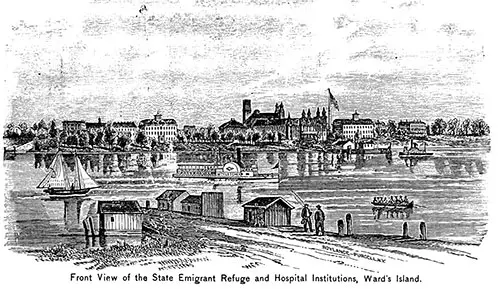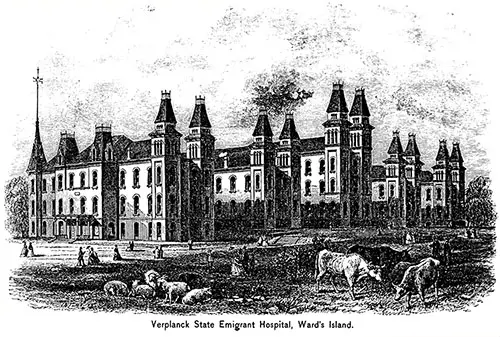Ward's Island Medical Center for Castle Garden Immigrants
Introduction
The article "Ward's Island - Hospital, Nursery, and Refuge Buildings" from 1871 provides an in-depth look at the facilities and services available on Ward's Island, which served as an extension of Castle Garden for the care and accommodation of immigrants in New York. The article highlights the critical role Ward's Island played in managing the health and welfare of sick, vulnerable, and destitute immigrants who arrived in America during the late 19th century. It details the structure and purpose of the various buildings on the island, including the hospital, nursery, and refuge facilities.

Front View of the State Emigrant Refuge and Hospital Institutions, Ward's Island, New York. Immigration, and the Commissioners of Emigration of the State of New York, 1870. | GGA Image ID # 14bc16b8ec
The Commissioners of Emigration own Ward's Island, New York, which contains about 200 acres and is situated in the East River, a few miles from Castle Garden. The Island includes the State Emigrant Refuge and Hospital Institution.
Every immigrant landing in New York is charged $2.50 head of commutation money, which is not paid directly by him but by the steamship companies and is included in the passage money.
This payment, as stated on page 65, entitles him, for five years after his landing, to free admission to the institutions on Ward's Island. The island is the property of the Commissioners of Emigration, containing about 200 acres, and situated in the East River, a few miles from Castle Garden. It was purchased, and all the improvements were erected out of funds accumulated from the head money.
Note: Head money was later referred to as the US Head Tax.

Verplanck State Emigrant Hospital at Ward's Island, New York. Immigration, and the Commissioners of Emigration of the State of New York, 1870. | GGA Image ID # 14bc7936a5
The Buildings on the Island Consist Of:
The New Hospital
This spacious edifice, constructed upon the most approved plans for ventilation and all necessary comforts of the sick, is designed to accommodate 350 patients. It is composed of a corridor, 650 feet long and two stories in height, from which project five wings, each 130 feet long and 25 feet wide, and two stories high, except the central wing, which has three stories.
The Ward's-Island Hospital, on Ward's Island, was opened in 1876 to treat all classes of diseases, both male and female. It is under the Commissioners of Public Charities and Correction.
The Nursery
The children's home is a 120 by 190-foot wooden building with three stories, a basement, and a Mansard roof. It contains a dining room, playroom, bathroom, schoolrooms, sleeping rooms, and a Roman Catholic chapel.
The Refuge building and the New Barracks
The Refuge building and the New Barracks, two large brick structures, are designed to assist impoverished immigrants. These facilities offer temporary asylum to those who, despite being in good health, are unable to find employment or reach their final destination due to financial constraints. In return for this support, the immigrants are expected to contribute to the institutions on the Island through labor. This reciprocal arrangement ensures that both the immigrants and the institutions benefit. The Refuge primarily caters to females, while the New Barracks is designated for males.
Other buildings
Other buildings are the Dispensary building, the new Dining Hall (capable of seating 1,200 persons), the Protestant chapel, the Fever and Surgical Wards, the Lunatic Asylum, the Boys' Barracks, workshops, the dwellings of officials, and other appurtenances.
"Appendix," in the Handbook for Immigrants to the United States, Prepared by the American Social Science Association, New York: Hurd and Houghton, 1871, pp. 115-116.
Ward's Island Medical Center
A Vital Chapter in Immigration History
The article “Ward's Island - Hospital, Nursery, and Refuge Buildings” (1871) offers a compelling glimpse into the critical role Ward's Island played in supporting immigrants arriving in New York. Serving as an extension of Castle Garden, the facilities on Ward's Island provided essential care for sick, vulnerable, and destitute individuals. With its detailed descriptions of the hospital, nursery, and refuge buildings, this piece is an invaluable resource for teachers, students, genealogists, family historians, and history enthusiasts seeking to understand the humanitarian efforts that shaped the immigrant experience in 19th-century America.
Why This Resource Deserves Attention
- Historical Significance
Ward's Island demonstrates the systematic and compassionate approach to immigrant welfare during a transformative period in American history. The medical and social care offered here was crucial for integrating new arrivals into society. - Educational Insights
- Teachers and Students: A powerful case study for exploring themes of immigration, public health, and social welfare.
- Genealogists and Family Historians: Provides context for immigration records and insights into potential ancestors' experiences.
- Humanitarian Impact
The article showcases the island's innovative approach to care, from advanced hospital facilities to supportive refugee services, highlighting the collective efforts to meet immigrants' physical, emotional, and financial needs.
Key Features of Ward's Island Facilities
-
State-of-the-Art Hospital:
A facility accommodating 350 patients, built with modern designs for ventilation and comfort, showcasing advancements in medical care for immigrants. -
Nursery for Children:
A safe haven with amenities like schoolrooms, a playroom, and a dining hall, providing children a chance to thrive while their families stabilized their lives. -
Refuge and Barracks:
Temporary shelters for destitute immigrants, offering food and lodging in exchange for labor, empowering them to regain independence. -
Additional Buildings:
Fever and surgical wards, a lunatic asylum, and Protestant and Catholic chapels reflect the holistic care available to immigrants.
Historical Importance
Ward's Island was more than a refuge; it was a lifeline for thousands of immigrants who faced illness, poverty, or uncertainty. Its facilities represent a humane and organized response to the challenges of mass immigration, setting a precedent for modern public health and social welfare systems.
Call to Action
Exploring this Castle Garden section and Ward's Island's pivotal role offers an unparalleled perspective on immigrant care in 19th-century America. Whether you’re delving into your family’s history, educating students about immigration, or uncovering stories of resilience and adaptation, Ward's Island is a cornerstone of America’s immigrant heritage. Visit this resource to connect with the past and discover the origins of the compassionate care systems that continue to shape our society.
